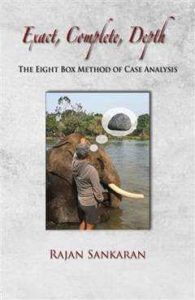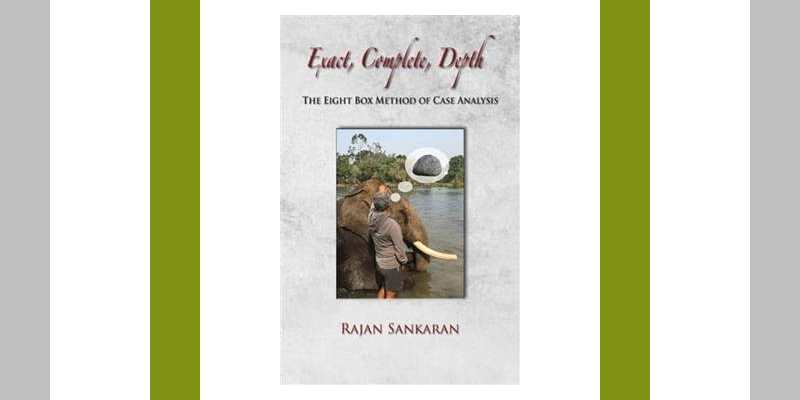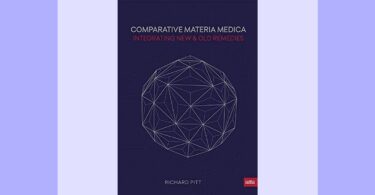
184 pages
Printed in India
Hardback
Published by Homeopathic Medical Publishers
ISBN 978-93-80355-67-2
Price £20 https://www.homeopathicbooks.com/product/exact-complete-depth-rajan-sankaran/
When I was at the Society of Homeopaths Conference in London this year (2018) Sankaran appeared to us via video link and I was so impressed with what he told us about his 8 box method I decided to get the book to review. It is a relatively small hard backed book with the usual Indian quality paper and print!
The Introduction tells of the Indian parable of the blind man and an elephant to illustrate the range of fallacies and truths which Sankaran equates with homeopathic case taking, with its different approaches and methodologies. He explains that the 8 box method enables us to clearly locate each aspect of a case.
The first chapter is entitled, ‘Revolution: From Synergy to Eight Box Method’. He begins by briefly reminding us of how Burnett, Kent and Boger analysed a case and then how he analysed a case by initially finding the Delusion and then expanded this to finding the Sensation. He came to the realisation that homeopaths followed 1 of 2 routes; those who wanted to use the symptoms of a case and those who used the Kingdom method. He explains that he thinks that these are both valid ways and so he came up with the Synergy approach,which stems from the triangulation of the Genius (central thread), the Symptoms and the System of a case. The Genius is “the most essential nature and pattern of the remedy”, the Symptoms are “Traditional Materia Medica, Provings, Rubrics” and the System is “Sensation, Kingdoms, Remedy Source and Miasm”. He also introduces the idea of an Anchor as the “first, clear, sure, definite, concrete thing we see in a case”. He continues that the 8 aspects aka 8 boxes are: Pathology, Local symptoms/Chief complaints, Physical generals, Mental symptoms, Dreams/Delusions/Fears, Kingdom/Sub-kingdom/Source, Miasm/Pace, Pattern/Genius. Once all these aspects have been established the idea is to find the clearest one as the starting point to finding the remedy.
In the next chapter ‘The Elements of the Eight Box’, Sankaran elucidates and describes in detail each of the boxes in turn, fully explaining the meaning of each of the titles he has given them. As an example, in Pathology he states that local symptoms must be complete as to their location, sensation, modalities and concomitants. Within the Physical Generals he includes the Exciting Factor which what I would call the aetiology. In the Mental symptoms he points out how important it is to individualise and not take common factors of the problem. Within the Dreams there is an interesting discussion about imagery as a way of reaching the sensation which I found very useful. The Pattern is the connection between the Eight boxes. There is a large discussion on what is the Centre of the Case as it is important to put our full attention on this. The example case that was used to explain this really brought it home to me. At the end of this chapter he talks about the Levels of Experience and how this shows what potency to give e.g. Level 2 Fact and Modalities 30C/LM 3 and 4, Level 6 Energy 50M /LM 11and 12.
The next chapter has the same title as the book, ‘Exactness, Complete, Depth’ and in it we are given a couple of cases to explain what he means. I do like books which are littered with case histories as they make it so much more readable. Following this is a short chapter on ‘Matching the Intensity’, which is also explained via a case.
‘Hints on Case Taking’ is the title of the next chapter and I am sure you agree that we can never get enough of these. Some of these hints I will be taking on and trying as they are new to me despite my nearly 20 years of experience. The following chapter is also about case taking but according to ‘Levels of Experience’. This means that “different cases require different techniques”. Sankaran goes through 5 different types of technique which are all illustrated with case examples.
Now we start on ‘Working a Case with The Eight Box Method’ in the next chapter and following this is a chapter called ‘Confirmation’ which is the last step of the puzzle and is how “we must match the essence of the patient to the essence of the remedy”. This is illustrated with a couple of practical examples.
The majority of this book contains 9 chapters illustrating the Eight Box Method ranging from a ‘Case of Eczema’ to a ‘Case of Anxiety Disorder’ and others in between. Each one contains illustrations, repertorization charts and of cause the Eight Box chart written out according to the case history that was taken. Some cases are in question and answer format which are very illuminating.
After the Cases section there is a chapter entitled “Possible Errors with The Eight Box Method”. Sankaran is such a good teacher, as everything has been thought of. Next there is “Thinking Outside of the Boxes”. We are told that this can happen in a case which needs the iatrogenic causation remedy and a case example is given. On the next page is a case that the reader can use to try out the Eight Box Method and he gives the page number where the solution is given!
The last chapter is called ‘Afterword’, which gives more information on this method including the mnemonics to represent the Eight boxes and a second set of mnemonics to show the steps needed to make this method effective.
Overall this is a book in which Sankaran teaches his new method brilliantly and leaves no step unturned. His teaching method is easy to understand and of course with a book rather than a lecture, you can always go over it again.
I would recommend this book highly for both students and experienced practitioners. I think everyone has something to learn from this book.
Videos about this method can be found at:
https://www.homeopathicbooks.com/product/exact-complete-depth-rajan-sankaran/
and at




